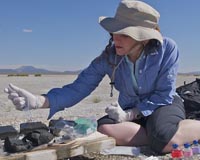 |
Livermore CA (SPX) Dec 03, 2010 Arsenic - an element that triggers death for most Earthly life forms - is actually allowing for bacterium to thrive and reproduce. In a study that may prompt the rewriting of textbooks, a team of astrobiologists and chemists has found the first known living organism that can use arsenic in place of phosphorus in its major macromolecules. The new findings could redefine origins of life research and alter the way we describe life as we know it. Oxygen, carbon, hydrogen, nitrogen, sulfur and phosphorous are the six basic building blocks of life on Earth. These elements make up nucleic acids, proteins and lipids - the bulk of living matter. The new study by Lawrence Livermore National Laboratory and led by NASA and the U.S. Geological Survey has found that a bacterium isolated from Mono Lake may substitute arsenic for phosphorus to sustain its growth. Mono Lake, located in eastern California, is an alkaline and hypersaline lake with high dissolved arsenic concentrations and is believed to have formed more than 760,000 years ago from neighboring volcanic eruptions. Felisa Wolfe-Simon, a NASA astrobiology research fellow in residence at the USGS and the paper's lead author, has been studying possible arsenic based life forms at the lake for some time. Using samples from Mono Lake and a culture medium with reduced phosphorus levels, she showed that that a strain of Gamaproteobacteria can not only survive using arsenic but can grow as well. "We know that some microbes can 'breathe' arsenic, but what we've found is a microbe doing something new - building parts of itself out of arsenic" Wolfe-Simon, said. LLNL's Jennifer Pett-Ridge and Peter Weber were able to identify low concentrations of arsenic found in individual cells of bacteria and extracted DNA. NanoSIMS is a tool which allows precise, spatially explicit, elemental and isotopic analysis down to the 50-nanomenter scale; it also offers a range of advantages for sensitive and high-resolution measurements. "It turned out the organism was able to tolerate these heavy metal concentrations (that are found in Mono Lake)," Pett-Ridge said. "Arsenic is right below phosphorous on the periodic table and it may have found a way to substitute arsenic for phosphorous in its biological makeup." Cultures of the Mono Lake samples produced flourishing colonies of the bacterium cells, as expected, when fed a steady supply of phosphorus, along with other necessities. When researchers removed the phosphorus and replaced it with arsenic, however, the microbes continued to grow. Subsequent analyses indicated that the arsenic was being used to produce the building blocks of new cells. "The team hasn't yet established how the organism uses arsenic as a building block when it's a poison to most other life forms," Pett-Ridge said. "It could be an ancestral trait or a unique kind of metabolism. Or it could be that it lives in an environment where arsenic is very high and it found a niche to survive." "This organisms' metabolic lifestyle suggests that life based on non-typical elements may be possible," Wolfe-Simon said. "This is important to scientists looking for clues to life on other planets." NanoSIMS not only measures the elemental concentrations, but it also images them. It collects a picture of the image and identifies how much of a specific element is found in the sample. "We found that arsenic was higher in the cells than in the environment outside the cells," Pett-Ridge said. "It's very difficult to make these measurements because the sample concentrations of arsenic are very low," she said. "But it's clear that the cells are incorporating arsenic into them. There are not a lot of organisms on the planet that can do this." The next step is to conduct protein biochemistry to find out if there are specific enzymes that help transport arsenic into the cells. Other collaborators include NASA Astrobiology Institute, Arizona State University, Duquesne University, Stanford Synchrotron Radiation Lightsource and BEYOND: Center for Fundamental Concepts in Science at Arizona State University. The LLNL NanoSIMS facility began via a grant from the Department of Energy's Office of Science Genomes: GTL program.
Share This Article With Planet Earth
Related Links Lawrence Livermore National Laboratory Exobiology at NASA NASA Astrobiology Institute Life Beyond Earth Lands Beyond Beyond - extra solar planets - news and science
 Arsenic-Eating Bacteria Points To New Types Of Life
Arsenic-Eating Bacteria Points To New Types Of LifeMoffett Field CA (SPX) Dec 2, 2010 One of the basic assumptions about life on Earth may be due for a revision. Scientists have discovered a type of bacteria that thrives on poisonous arsenic, potentially opening up a new pathway for life on Earth and other planets. If you thumb through an introductory biology textbook, you'll notice that six elements dominate the chemistry of life. Carbon, hydrogen, oxygen and nitrogen are ... read more |
|
| The content herein, unless otherwise known to be public domain, are Copyright 1995-2010 - SpaceDaily. AFP and UPI Wire Stories are copyright Agence France-Presse and United Press International. ESA Portal Reports are copyright European Space Agency. All NASA sourced material is public domain. Additional copyrights may apply in whole or part to other bona fide parties. Advertising does not imply endorsement,agreement or approval of any opinions, statements or information provided by SpaceDaily on any Web page published or hosted by SpaceDaily. Privacy Statement |